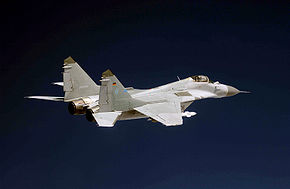| MiG-29 | |
|---|---|

| |
| Primary function | Air-superiority, multi-role fighter |
| Primary contractor | Mikoyan-Gurevich OKB |
| Unit cost | $29 million (U.S.) |
| Models | A: MiG-29 basic version B: MiG-29UB trainer C: MiG-29S D: MiG-29K, MiG-29KUB, naval versions E: MiG-29M upgrade test plane F: MiG-29OVT, MiG-35 thrust-vector control engine |
| Date entered service | 1983 |
| Countries in use | USSR / Russia (country of origin) Belarus, Bulgaria Croatia, Cuba, Czech Republic, Germany Hungary, India, Iran, Iraq Kazakhstan, Malaysia, Moldova North Korea, Poland, Romania Slovakia, Syria, Turkemenistan Ukraine, Uzbekistan, Yemen, Yugoslavia |
| Specifications | |
| Wingspan | 36 feet, 5 inches |
| Length | 56 feet, 10 inches |
| Height | 15 feet, 6.25 inches |
| Weight | 24,030 pounds empty |
| Ceiling | 59,100 ft |
| Speed | Mach 2.3 maximum |
| Range | 905 nnautical miles |
| Propulsion | Two Klimov/Sarkisov RD-33 turbofan engines |
| Thrust | 22,200 pounds |
| Crew | One |
| Armament | One 30mm GSh-30L cannon, 150 rounds |
| Payload | 2x AA- 8 Aphid (R60) 2x AA-10 Alamo (R27T) 2x AA-11 Archer (R73) FAB 500-M62, FAB-1000, TN-100, ECM Pods, S-24 AS-12, AS-14 |
The MiG-29, known to Western operators as the "Fulcrum," is a Soviet-built air superiority fighter. It is a widely exported aircraft, used by more than 20 countries, among whom are Iraq, Iran, North Korea, and Cuba.[1] At shorter ranges, it is equal to the F-15, but at ranges of eight miles or more, the F-15 and F-18 are superior.
The MiG-29 was designed to meet a 1972 requirement for a maneuverable, high-tech fighter to replace the MiG-21 and MiG-23. The first prototype flew in 1977, and the Fulcrum entered operational service in the mid-80s.[2]
The Department of Defense acquired 21 "Fulcrums" from Moldova after learning that Iran had inspected the aircraft and were attempting to purchase them. Fourteen of the aircraft were the advanced "C" version, which carry a radar jammer.[3]
Operational History[edit]
The Syrian Air Force acquired the new MiG starting in 1987, but it has had little success in clashes with Israeli fighters. On September 14, 2001, two Fulcrums threatened an IAF 707 on an intelligence gathering mission, and were promptly shot down by F-15s. Both Syrian pilots were recovered safely.[4]
During the Gulf War, Iraqi MiG-29s challenged the initial Coalition air strikes, but five were shot down by USAF F-15s in the first few days, and they never came close to being a serious threat.[5]
MiG-29s were used by the Yugoslav Air Force during the Yugoslav Civil War. On May 2, 1992, one was shot down by a Croatian SAM, the pilot surviving to become a POW.[6] When Operation Allied Force began, five Fulcrums were downed by NATO fighters in the first three days, with another falling to an American F-16 later in the campaign. By this time, Serbian MiGs suffered from lack of spare parts and proper radar support, so were not able to seriously challenge the NATO airstrikes.
On February 24, 1996, a Cuban Air Force MiG-29 shot down two unarmed Cessna prop planes over international waters. The Cessnas were flown by members of Brothers to the Rescue, an anti-Castro activist organization. All four pilots were killed, and the Cuban government was widely condemned for the incident.[7][8]
References[edit]
- ↑ Mikoyan MiG-29 Fulcrum
- ↑ The Vital Guide to Military Aircraft, ed. by Sophearith Moeng, Airlife Publishing, 1994
- ↑ War in Moldova, 1992
- ↑ Israeli-Syrian Shadow Boxing
- ↑ F-15C Eagle Units in Combat, by Steve Davies, Osprey Publishing, 2005
- ↑ MiG-29 Fulcrum Losses and Ejections
- ↑ University of Minnesota Human Rights Library
- ↑ Shootdown of Brothers to the Rescue Planes